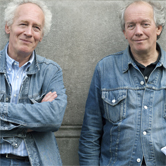In the new movie by filmmakers Jean-Pierre and Luc Dardenne, The Kid With a Bike (opening Friday at the Angelika Film Center), the Belgian brothers find themselves in familiar territory, a quaint, if down-toned Belgian town populated with working class people for whom life is a struggle. The kid in the title is Cyril Catoul (Thomas Doret), a boy around 11-years-old who has been abandoned by his young father, Guy (Jérémie Renier), and is eventually taken in by Samantha (Cécile De France), a sketch of a character who literally bumps into Cyril by happenstance and is taken up in the struggle for his life.
Like all of the Dardennes work, whose six feature films made since the mid-1990s after a career as documentarians have all been received with enthusiastic critical acclaim, The Kid With A Bike is a hard, visceral movie, shot in a documentary style – at times frantic, other moments as steady as a still life – with the life of the characters spilling out on either end of the movie’s narrative arc.
Speaking via phone through a translator, and in between off-handed jokes and fraternal jabs, the upbeat Dardenne brothers said that their seemingly improvised, immediate style is similar to the fictional world they create, the product of a mix of theatrical restraints and liberties.
“There is a conflict with the space; it is as if the camera hasn’t been planned to fit into it,” Jean-Pierre Dardenne says. “We also shoot in continuity. We need to rehearse the movement so that the actors can be very present, so that when the audience is watching the scene unfold, they don’t have a sense of someone behind the camera directing it like a puppeteer.”
Luc added that the unmistakable style is directly related to their documentary work.
“What we learned from our documentary work is that life exists and we film it,” Luc says. “And we wanted to put that feeling in our films – to have a sense that life was happening before the camera was rolling.”
The result is a cinematic style that feels effortless, and it is the effortlessness of the film’s rhythm and flow that makes the movies so deeply involving. It is only upon reflecting on the films that we realize that we have been connected so intimately with characters that are largely foreign to us: drug abusers and thugs, human traffickers, and the dregs and desperate of society. But this again is what fuels the power of the Dardennes’ movies, the slightest amplification of the essentially human characteristics that shine when life is lived on the fringe, intensified by the post-industrial European landscape.
“It is true that we set our films in a rough environment,” Jean-Pierre says. “The sets are usually in rough locations; the style of the movies are rough. But with The Kid With a Bike, there is an element of The Son (the brothers’ third feature), which is warming the film. Deep down, it is what we are convinced of, that we can be saved.”
“Saved” is a qualified concept in the Dardennes’movies. The environments are so physical and Darwinian that salvation can mean something as simple as encountering human kindness in a world defined by a brute, animalistic cruelty. In The Kid With a Bike, that kindness is provided by Samantha, who takes in Cyril for unexplained reasons. The boy runs into her in the film’s early moments, as he dodges the pursuit of his caretakers at a foster home in an effort to track down the father who has abandoned him. From the film’s first few flashes we understand that Cyril’s situation is one of impossible desperation. Cyril might become a statistic, a child whose fate and circumstance have pre-determined a life of crime or abuse. But instead, the Dardennes introduce Samantha.
“We wanted her to remain enigmatic,” Luc says. “We didn’t want reasons in her past to be explained in her character – we didn’t want to paint a psychological portrait so the audience can pull back and understand her psychological reasons.”
The character of Samantha is very much born of the Dardennes’ overall style: open-ended, enigmatic, simultaneously elusive and involving.
“We wanted the audience members to be Samantha,” Luc says. “We want them to think of what motivated her, to think, ‘I don’t know why she did it, but I’m glad she did.’”
That question of Samantha’s motivation, which lingers with you as you leave the theater, contains the secret of what makes the Belgian filmmaking team such effective storytellers. The glimmering of hope in their films remains a mystery, but we recognize it and believe it, if only because the movies demand from us a similar kind of veiled optimism.





